"Lastly I say to my seniors and friends: Please make good movies." |
| From the last will and testament of director Yamanaka Sadao* |
Given that the above quote was the very same one that headed my 2005 review of the earlier Masters of Cinema DVD release of Yamanaka Sadao's Humanity and Paper Balloons, you think I'd at least try to find something different to put at the top of this one. But in its exquisite simplicity, particularly as the final request on the filmmaker's last will and testament, it's impossible to beat, and given the nature of this release, is even more at home here than it was on that earlier review. Indeed, much of what should be said here I have already written in the opening paragraph of that review, and rather than ask you to ping-pong between the two pieces, I'm going to borrow liberally from that intro here. If you've not read that piece then you'll have no need to now, as the review of the film itself has also been reproduced below, with appropriate amendments. To those who may have recently read it, I apologise for the repetition.
To have concluded his will with a polite request that his contemporaries make good movies does give a flavour of the passion Yamanaka must have had for his craft, and given that those contemporaries included Ozu Yasujirō, Shindō Kaneto and Mizoguchi Kenji, it's a request that appears to have prompted an enthusiastic response. And these were not the wishful words of an interested observer – Yamanaka also made good movies and, apparently, several genuinely great movies, but we have been left with tragically little evidence with which to judge this. Any talent cut short prompts a sad sense of what might and should have been, but the hand of fate really did issue Yamanaka a slap. A young and prolific film-maker, he began his career as a writer and assistant director at the age of 20 and directed his first feature a mere five years later. Between 1932 and 1937 he directed twenty-two features, the last of which was Ninjo kami fusen [Humanity and Paper Balloons]. The very day of the film's premiere, Yamanaka was drafted into the army and a year later died in a field hospital in Manchuria. During WW2, a combination of studio neglect and the devastation caused by allied bombing destroyed a large number of Japan's pre-war film output, including a dismaying nineteen of Yamanaka's features. Just three survive to this day. Previously, we in the UK only had access to his final film, and on the evidence of that alone he was clearly a filmmaker of considerable skill. But presented with three films with which to measure his talent, it's evident that he was not just capable of producing great work, but consistently great work.
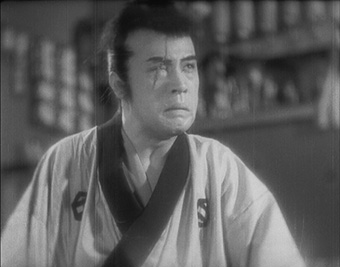
The three films here represent the only surviving material from a prolific but tragically brief career: Tange Sazen Yowa: The Million Ryō Pot (1935); Kôchiyama Sōshun (1936) and Humanity and Paper Balloons (1937). All three are jidaigeki, or period films, which was Yamanaka's speciality. That even these three survived is perhaps a small miracle and the condition of the source prints is thus far from perfect, something I'll expand on a little below. But I urge you not to be dissuaded by this, as the films themselves – and the fact we are able to see them at all – more than compensate for any shortcomings in the sound and picture quality.
| Tange Sazen: The Million Ryō Pot |
|
Tange Sazen, or to give it its full title, Tange Sazen Yowa: Hyakuman Ryō no Tsubo [The Obscure Story of Tange Tanzen: The Million Ryō Pot], sets up the story essentials with such speed that if you sneeze a couple of times you'll probably miss out on some crucial details. As the titles conclude, we learn that the influential Lord Yagyu has discovered that the decoration on a seemingly worthless pot that he gave to his younger brother, Lord Genzaburo, may actually point the way to a million Ryō treasure. He thus dispatches a loyal emissary Ko Dainoshin to Genzaburo's house to request its return.
I should perhaps pause here to admit that I've no idea how much a million Ryō might be worth in the pounds, dollars or Yen of today. Few people do. This was the currency of pre-Meiji era Japan and we can only take a guess at its value based on the the description here of 60 Ryō as "a large sum of money." (For the record, one Ryō was worth about sixty monme – or mon as they are called here – and I don't know how much one of those was worth either.)
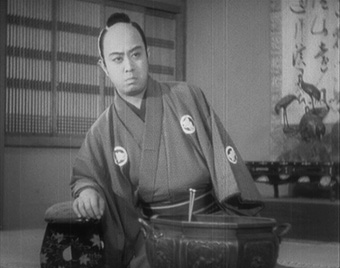
But I digress. Genzaburo, of course, knows nothing of the value of a pot that his wife Hagino detests and would like to dispose of, and that Genzaburo only keeps because it's a Yagyu family heirloom. He suggests that it might fetch one Ryō if they sold it; Hagino opines that they'd be lucky it made three mon. But when Dainoshin arrives to take it off their hands, Genzaburo refuses to hand it over. For some time he has held a grudge against his brother, who inherited all of the family's land and wealth, while all he received was this old pot, and now Yagyu wants to take that back as well. Out of spite he tells Hagino to flog it to local scrap dealers, a comically mismatched duo with their own theme music. After taking advice from a local clan leader loyal to Lord Yagyu, Dainoshin returns and offers a hundred Ryō for the pot. Genzaburo, as you might expect, smells a Shogun-sized rat. When Dainoshin pleads ignorance of Yagyu's intentions, Genzaburo has him hauled off to the dojo and the truth beaten out of him. Unfortunately for everyone, Hagino has since dutifully acted on her husband's wishes and sold the pot to the now departed scrap dealers...
In case you think I'm giving away a little too much plot, know that all of this happens in the first ten minutes and we haven't even met the film's title character yet. In terms of the narrative, we're just getting started.
Now where was I? Oh yes. Also unaware of the true value of the pot, the scrap dealers return home, where the more cheerful of the pair gives it to young Yasu to keep his goldfish in. Yasu is the son of their neighbour Shichibei, who secretively spends his evenings at an intriguing tea house where the patrons can relax by shooting arrows at targets from the comfort of their dining area (a Japanese friend assures me this was common at the time), an establishment whose master is a grumpy ronin named Tange Sazen.
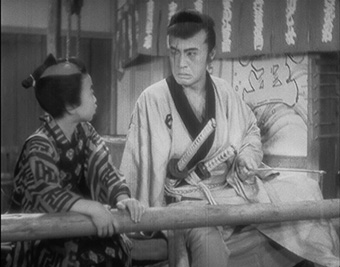
It's worth noting here that Tange Sazen was once an icon of Japanese literature and film, a one-armed, one-eyed and nihilistic swordsman of considerable skill whose most popular film incarnation was the one played by celebrated chanbara actor Ōkōchi Denjirō. And it's Ōkōchi who plays him here, though in a more comical vein than his previously straight interpretations, appropriate to the light-hearted tone of the film. He first appears when driven outside by the tea-house Madam's singing, but makes a sharp and forceful return when Shichibei is set upon by two gruff patrons he has inadvertently humiliated. What happens next is best left for the film to reveal, but a short while later we're back with the agitated Genzaburo as he tries to convince his wife that he should go in search of this valuable pot, a task that he estimates could take him several years. This is actually a blind to allow him to spend his days relaxing at a familiar-looking tea house guarded by a certain one-eyed swordsman...
An engaging comedy of errors unfolds in which Genzaburo makes urgent enquiries about the location of a pot that is never more than a few yards away from where he is sitting. This reaches a near absurdist peak when he cheerfully interacts with Yasu and repeatedly fails to realise that the pot in which the boy keeps his goldfish is the one he is seeking. For the most part it's not that he fails to recognise the vessel, but that he always seems to be looking in the wrong direction when Yasu carries it into the room. At one point he's even talking to Sazen about its value while the pair are catching more goldfish for Yasu to drop into the very pot in question – there's almost a sense by this point that Yasu is the only one able to see it. This level of unforced farce is amusingly developed as the pot continues to remain oddly invisible to those sitting beside it, yet is spotted from the balcony of Genzaburo's own home by a servant with a telescope, a device that is then passed to Hagino to expose her husband's philandering.
What really caught me out about Tange Sazen is the modernity of its more cinematic humour. Yamanaka clearly understood the comic potential of the neatly timed edit, a technique at its funniest when Genzaburo's initially hopeless attempts to hit a target at the tea house dissolve to an image that made me laugh so hard I nearly choked on my coffee. And in what has to be one of the earliest examples of a gag whose overuse since has seen it pass into cliché, Yamanaka more than once has a character adamantly refuse to undertake a task and then cuts to them in the process of doing it anyway.
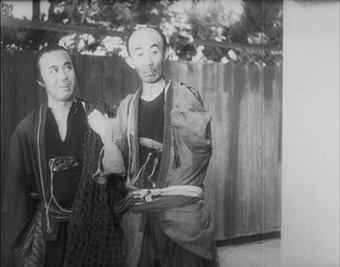
As the story progresses, whether Genzaburo will actually locate the pot becomes of secondary importance to his bumpy relationship with Hagino – who now refuses to let him out of the house – and Sazen's gradual if reluctant acceptance of his role as surrogate father to Yasu. But even these scenes are often comedic in nature: Genzaburo's secretive use of "nose oil" to help catch fish; his pathetic pleads to his wife to be let out for just one day; the beating he takes from his own servants when he is mistaken for a thief while trying to sneak back in at night; Sazen's habit of turning the teahouse welcome cat statue (a commonly seen icon in Japan even today) to face the wall every time the Madam sings, an action that – in the manner of a true surrogate son – Yasu later copies. When the search for the pot is resumed, Yamanaka ups its cinematic ante with a sequence of eye-popping scale, where what looks like everyone the production could lay their hands on and wrap in costume simultaneously responded to a poster offering a reward for its return.
Tange Sazen is a genuine delight, a skilfully assembled and consistently entertaining blend of character comedy and period drama whose humour occasionally borders on the surreal. The lightest in tone of the three films here, it nonetheless shares with them their unwaveringly confident way with multiple characters and interconnected stories, and the inclusion of traditionally heroic figures who are defined less by their actions than their all-too-human flaws.
Somewhat freely adapted from a popular kabuki play by Mokuami Kawatake and more serious in tone than Sange Tazen, Kōchiyama Sōshun (peculiarly retitled Priest of Darkness in the US, which frankly makes it sound like a Hammer film from the late 1960s) is no less ambitious in its multi-threaded story and the sheer number of characters we're required to keep tabs on. First up is Kaneko, a walking-stick ronin who's out collecting money from local businesses for the boss of the district. No-one gets a free ride here except attractive sake seller Onami, whom Kaneko has a bit of a thing for and whose brother Hirotaro has responsibility and maturity issues, despite his dislike of being treated like a child. In the course of his rounds, Kaneko is pestered by old acquaintance Kitamura, now the chief retainer for a local lord and who, in the course of attempting to engage Kaneko in conversation, leaves his sword at Onami's stall. When he returns to collect it, the small ornamental dagger that sits on its scabbard has disappeared. So has Hirotaro, who just a short while before was showing some interest in the object in question. You can draw your own conclusions. Kitamura certainly does.
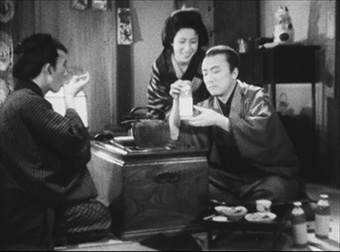
Later that evening, Onami visits a gambling house run by the Kōchima Sōshun and his wife Oshizu in order to ask Hirotaro to come home, but is informed that there's no one of there of that name. As it happens, Hiro is upstairs but not keen to be found. He thus introduces himself to Kōchiyama – whom he knows by reputation and earlier watched outwit street gambler Ushi – as Nao, and so taken is Kōchiyama with the young man's seemingly heroic drinking skills that he takes him to Yoshiwara (a once famous Edo red-light district) for an evening of sake, women, and in Hiro's case vomiting. It's here that Hiro bumps into the pretty Omitsu, a close childhood friend who is now working as a Yoshiwara geisha.
To continue to detail the various plot threads would rob first-time viewers of the enjoyment that comes with seeing how they unfold and interconnect. As further characters are introduced, you'll need to pay close attention if you're going to keep track of just who is who as they pop in and out of the narrative, their stories continuing regardless of whether they're on screen or not. Intermittently you'll be required to fill in the gaps, to work out, for example, how Hiro and Omitsu go from being reunited childhood friends to a potential double suicide after a single date, one we only learn took place thanks to an almost throwaway exchange between Kaneto and Ushi.
Given the title, it's perhaps surprising that there is no specific focus on Kōchiyama until the final scenes, and even then he's on an equal footing with a reinvigorated Kaneto. I'm not in a position to comment on how strongly he figured in the original play, but this film adaptation (the third, I gather) is very much an ensemble piece, one whose narrative is made up of a string of inter-related sub-stories, each of which directly or indirectly affects the others. Communication between characters is frequently misread or misdirected, seemingly innocent actions sometimes have unexpected consequences, and significant encounters often occur by chance. Indeed, luck (both good and bad) plays a major role in the story development, most evident in the manner in which the knife stolen from Kitamura ends up back in his hands, a circular journey that impacts on almost all of the sub-stories and helps to prepare Kōchiyama and Kaneto for a climactic confrontation, one actually driven by a different (but related) sub-story.
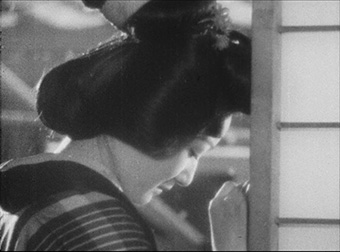
In many ways Kōchiyama Sōshun anticipates Humanity and Paper Balloons, in its tragedy-tinged drama, its busy cast of characters, its fascination with those of lower social status, and the confidence and skill with which the multi-stranded narrative is structured and handled. Complex but never confusing, it provides further evidence of Yamanaka's real skill as both a filmmaker and storyteller. Those who relished the lighter tone of Sange Tazen will also find a few moments to treasure, from the comical bidding war between two potential buyers for Kitamura's knife, to Kaneto's outrage at the suggestion that one of his legs is shorter than its companion. "Fool!" he angrily tells Kōchiyama, "One leg's just longer than the other!"
| Humanity and Paper Balloons |
|
Humanity and Paper Balloons [Ninjo kami fusen], Yamanaka's final film, invites readings that take in not only Japan's feudal past, but also its then pre-WW2 present. In a small town during the Edo period, a penniless samurai hangs himself. As the death is investigated, men working for local gang boss Yatagoro are searching for ex-hairdresser Shinza, who has been organising gambling parties on the gangster's territory without his permission. Living next door to Shinza is Unno, a poor Ronin who is attempting to curry favour with local official Mori, whose present position of power is in part due to Unno's late father. Mori, meanwhile, is assisting wealthy local merchant Shirakoya, whose daughter is due to be married to the son of a noble samurai, but she is secretly in love with Shirakoya's clerk Chushichi.
And this is just the set-up. Right from the start, the story unfolds less through on-screen action than casual conversations between the local workers and tenants, the connections between the multi-stranded narrative developed with disarming deftness. There is no introductory voice-over or caption, and some aspects of the story are already in full flow when the film begins and only become clear with the passing of time. Our first encounter with Shinza, for instance, sees him pursued by Yatagoro's men – we don't know the identity of either party or why one is chasing the other and are invited to piece together the information from sometimes offhand moments in scenes that follow, some of which, such as the drunken wake for the dead samurai, seem initially to be staged more for the fun of it than to advance the plot.
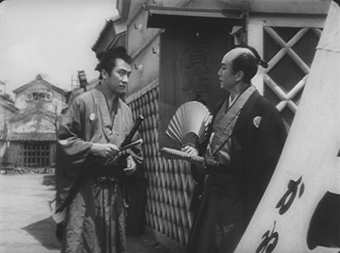
Initially a busy ensemble piece in which the minor characters are given the same amount of screen time as the leads, the main story threads develop simultaneously, as Unno's attempts to simply pass an introductory letter from his father to Mori are repeatedly rebuffed, Shirakoya's daughter and Chushichi grab what time they can together, and Shinza cheerfully ignores Yatagoro's warnings to cease gambling in his territory and continues to organise games. All three stories become entwined when Shinza, unable to raise money by pawning his hairdressing tools, kidnaps the young bride-to-be, the motivation for which proves to be not what we are initially led to suspect.
Made in collaboration with the left-wing Zenshin-za theatre group, the film offers a dim view of life for those on the lower rungs of the social ladder and directly challenges the more commonly held view of the Japanese warrior spirit presented by jidaigeki drama. Here they are represented by three inglorious figures: an unseen nobleman who is picky about the social standing of the girl he marries; a self-important and ungrateful official; and a penniless and ineffectual ex-alcoholic who no longer seems able to defend himself in a fight. When you consider that this was made in the lead-up to a war in which that very warrior spirit was to prove a key aspect of Japan's fighting machine, this seems and extraordinarily bold and surprising move for any film of its day.
In the later stages, Yamanaka uses intention and suggestion in place of literal action, a move that may well have been prompted by censorship issues of the time. But its continued use by directors such as Kitano Takeshi, coupled with this film's thematic boldness and low-key approach, can't help but give it a disarmingly modern feel. Surprisingly, there is no incidental music at all and silence is frequently and powerfully employed as a narrative tool.
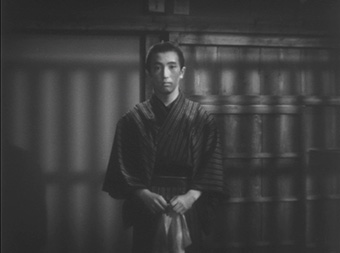
As a character drama, Humanity and Paper Balloons unfolds beautifully, the offbeat character comedy gradually giving way to drama and ultimately tragedy. The performances, especially given the story's kabuki origins, are remarkably natural, while the camera placement and editing provide the film with its pace and a good deal of its emotional drive. An almost claustrophobic sense of community is created by shots angled down the narrow lane in which Shinza and Unno live, which is almost always busy with people, and although close-ups are rare and restricted to objects rather than people, the 1.37:1 frame allows mid-shots to be used to surprisingly telling effect – at a key point in the story, the camera lingers for far longer than you would expect on a static and rain-drenched Unno, his face a mask of crushed disappointment after blunt rejection from Mori. It's moments like this – immaculately judged, understated and intensely moving – that really bring home what a loss to cinema – and to humanity – the death of Yamanaka and the destruction of so much of his work actually represents.
Before approaching any of the films in this package, it's important to remember that these are not restorations of well preserved classics but the only surviving films of a body of work that has otherwise been lost. None of the them are thus in pristine shape and the condition of the source prints varies considerably. As so often, this is not really reflected in the included screen grabs, which I've chosen for their content rather than their visible flaws.
Of the three films here, Tange Sazen is, a liitle conversely, both the nicest-looking and most inconsistent transfer here, suggesting more than one print was sourced for the restoration. At it's best the image is impressive for a 1930s film, boasting a solid level of detail, a pleasing contrast range and next to no frame jitter – indeed, much of the material looks as good as you'd hope for a digitally restored tarnsfer of a film of this age. Intermittently, however, the sharpness and contrast soften, and just occasionally the dust, scratches and damage that are visible throughout intensify dramatically, though this is usually confined to a single shot. The soundtrack also suffers some stark shifts in quality and clarity. The inevitable range restrictions aside, the dialogue can sometimes be clear in one shot and then quietly muffled in the next, while the ever-present background hiss and crackle can sometimes leap in volume and is occasionally joined by a louder pop of damage. In a few sequences the music almost overpowers the dialogue, making me wonder if a separate music track was discovered and overlaid in the course of the restoration process. For my money the good points far outweigh the flaws – it remains very watchable and intermittently it shines.
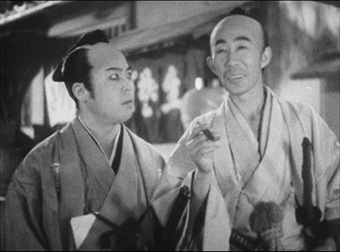
Despite being a later film, Kōchiyama Sōshun has not fared as well as its forebear and the signs are that the restoration here was sourced from a single surviving and ill-preserved print. The image itself is softer than on Tange Sazen, the film grain more prominent, the contrast less subtle, and several sequences are covered with a rainfall of scratches. But within these fate-imposed restrictions, this is still a very watchable transfer – the action and even facial expressions are always clear, and the frame jitter you would expect to accompany a print in this condition has been completely stabilised. The treble-biased, range-restricted soundtrack lacks the clarity of the best material in Tange Sazen and is accompanied by a loud background hiss and a few pops of damage, but the quality is consistent – once you get used to it, there are no nasty surprises.
Humanity and Paper Balloons has the cleanest of the three transfers and shows almost no sign of dust or damage. The contrast varies a little and never displays the tonal range or picture crispness of Tange Sazen at its best, and various shades of grey tend to stand in for black, though this does protect picture detail that would otherwise be swallowed. Once again there is no frame jitter. The soundtrack, despite the range restrictions, is probably the most consistently clear on the three films here (Tange Sazen does manage to outdo it, but only intermittently), and the audible background hiss is for the most part not intrusive.
Tange Sazen Extended Scene (2:06)
A brief extension to the sequence where Sazen is confronted by and defeats a small mob, material that existed only in the trailer, for which no sound version exists. The sequence itself is shown in the context of where it would originally have sat, followed by the trailer from which it was taken.
Two Fragments (5:02)
Two brief but still valuable surviving clips from earlier Yamanaka films – both rescued from shortened 9.5mm prints designed for home viewing – one from his 1932 first feature Genta of the Shore: The Longsword of Dakine [Iso no Genta Dakine nonagadosa], the other from the 1935/6 The White-Hooded Thief: First Volume + Follow-Up [Kaitō Shiro-Zukin: Zen-pen + Kō-hen]. Both are chanbara swordplay sequences, the one from Genta of the Shore being the longest and in the best condition (though both are unsurprisingly ragged). As an action scene it's impressively staged.
Tony Rayns (23:33)
The venerable Mr. Rayns provides a detailed and fascinating overview of Yamanaka's life and career as a widely acclaimed screenwriter and director, including his involvement with left-wing politics and how he was able to smuggle political messages into his films. He also provides a useful history of the character of Tange Sazen in literature and film, and even comprehensively covers the wartime decline of Japanese cinema.
Booklet
A redesign of the booklet that shipped with the Masters of Cinema DVD of Humanity and Paper Balloons with larger text (which is easier to read without glasses), and is none the worse for that, particularly if you don't have the earlier disc. The content is all excellent and includes an essay on the film by Aoyama Shinji, an updated and corrected piece by Tony Rayns, Yamanaka's Diary of an Idle Man from 1935, and an excellent article on the director by Satō Kimitoshi, which is peppered with quotes from Yamanaka and his contemporaries. Also included are stills, credits for the three films, and Yamanaka's last will and testament, which is quoted from at the top of this review and really is worth reading, not least for his instruction on how his debts should be paid. "Probably my money will not cover them all," he admits and then advises, "Cheat them to make them content with the result." How could you not love this man?
As I said on the release of the stand-alone DVD of Humanity and Paper Balloons, to lose a film-maker of Yamanaka's talent is bad enough, but to also lose most of his cinematic legacy is genuinely tragic. In that respect, this two-disc DVD form Masters of Cinema is unquestionably one of the most important home video releases of 2013, bringing together as it does all of the surviving film material directed by Yamanaka and complimenting it with a solid collection of supporting extra features. And it's all terrific. If you're a devotee of Japanese cinema, consider this an essential purchase. Even if you're not, this still comes highly recommended.
|